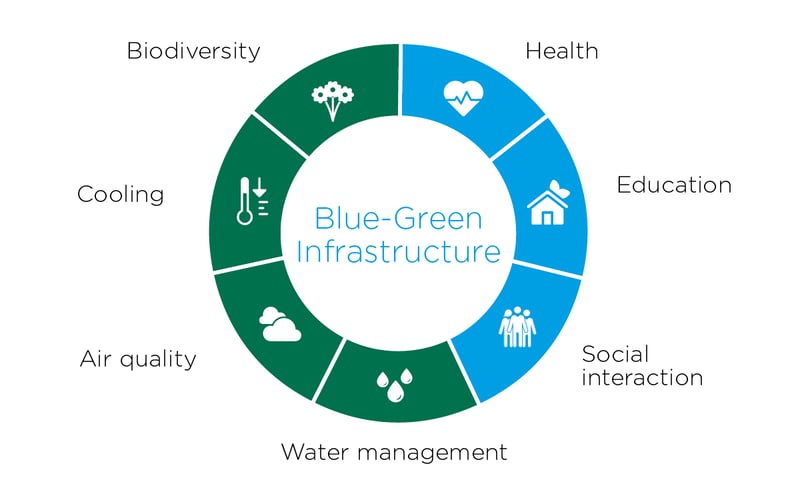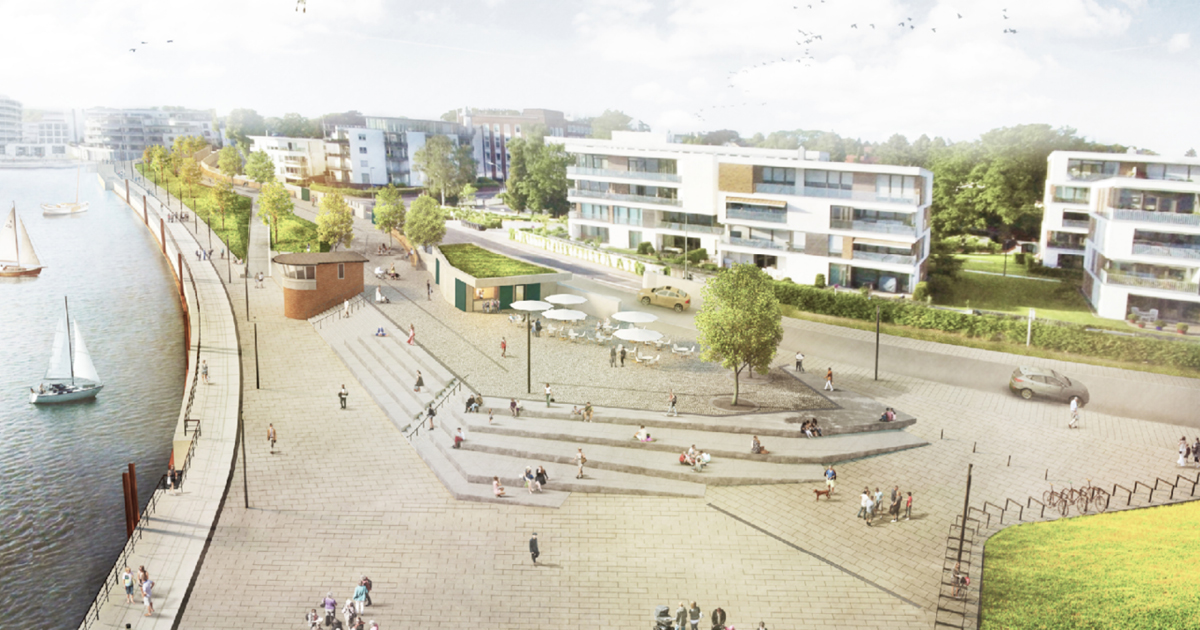
Insights
Climate Adaptation and Resilience: How Blue-Green Infrastructure Enables Livable Places
Scientists across the globe all agree that the future doesn’t look rosy. Natural disasters are inevitable. For example, the risk of flooding in cities and towns is increasing worldwide. This can no longer be prevented; we can only prepare for it with climate adaptation and smart landscape architecture that mitigates risks while creating livable and eco-socially attractive living spaces.
There’s no planet B.
What climate activists never tire of emphasizing is an issue that must lead to tangible action: what can we do to ensure people enjoy a good life on Planet Earth in the future? Firstly, we must do everything we can do to prevent the situation, i.e. climate change and its consequences, from becoming any worse. Secondly, we must also discover ways to deal with the damage already caused. This may sound gloomy and startling, but the situation is serious.
The silver lining in all of this, however, is that both risk mitigation and resilience in the building and construction industry are possible. There’s no doubt that things will never be the same again. Rebuilding broken dams or restoring cities to the way they once looked before being devastated by heavy storms and floods is not only difficult and expensive - it’s pointless. We have to acknowledge the fact that these disasters will happen again. What should be our approach then? In short, immediate optimization. Climate adaptation is paramount and should be done in a sensible, efficient manner and in such a way that the solution to a problem creates both: something new and sustainable.
What Does Blue-Green Urban Planning and Infrastructure Mean?
The problem? Due to climate change, weather and natural disasters pose a massive threat to the livability of many places, especially cities and metropolitan areas. Flooding is a major and very real threat, whether from heavy rain, rising sea levels or flooded rivers. At the same time, extreme heat and drought threaten cities and entire regions, both directly and indirectly, by exacerbating water-related issues. If heavy rain falls on extremely dry soil - like what occurred in the Ahr Valley region of Germany in summer 2021, the soil cannot absorb excess water, resulting in catastrophic flash flooding.
Innovative and smartly designed Blue-Green Infrastructure (BGI) offers a feasible solution. Blue areas of the city, i.e. water bodies, and green areas such as parks, plazas and natural areas, are designed to intercept water. BGI combines hydrological functions with urban nature, landscaping and urban planning - and does so extremely effectively. Building and maintaining such new infrastructure often costs less than repairing the damage and consequences of natural and weather disasters. Or to put it another way, the benefits of BGI usually outweigh the costs.
Both people and the environment benefit from this way of rethinking cities and building sustainably by putting climate adaptation solutions and resilience into practice.

Benefits for nature
- Biodiversity: Blue-Green Infrastructure has the potential to enhance as well as contribute to the preservation of biodiversity. Ecosystems typical to the respective area is preserved, e.g. in open spaces where there’s little or no intervention in the ecosystem and where regional diversity grows and thrives. Green infrastructure in the form of green roofs, facades, roadside greenery as well as brownfield remediation can also have an impact. There exists untapped potential in industrial and commercial areas, where large green fields or heavily paved areas could be replaced by open vegetation.
- Water management: Smartly designed collection areas mitigate heavy rainfall (surface runoff) and make water usable (water cleansing and storage).
- Cooling: Green spaces not only absorb large amounts of water; they also store the water and provide cooling by slowing down evaporation. Trees growing on them also provide additional shade (reduced heat island effect).
- Air quality: Trees and plants in cities filter dust and fine particulates, naturally cleaning the air and thereby ensuring enhanced air quality.
Benefits for people
- Health: Nature is good for us. Being outdoors and experiencing unspoilt nature has been proven to have a calming, healing effect. In short, living in close touch with nature is healthy!
- Education: Experiencing urban nature on a regular basis not only strengthens learning ability and brain development; it also broadens your horizons. There are no longer any typical city-dwellers with little awareness of the nature and environment around them. This is because even they’ve had the opportunity to experience both via Blue-Green Infrastructure.
- Social interaction: Green spaces for recreation and various activities bring the residents of a city closer together, which both increases the well-being of each individual and strengthens social cohesion.
Examples of Blue-Green Infrastructure and Buildings in Germany
From Copenhagen and Hamburg to Singapore and New York, Ramboll has implemented the idea of, and transformation to, meaningful and practical Blue-Green Infrastructure into buildings and entire neighborhoods around the world.
As Sustainable Society Consultants, Ramboll has adopted an integrated planning approach. What does this mean? In concrete terms, even before a project starts, Ramboll conducts feasibility studies, assesses socio-economical potential, costs, benefits and value. In doing so, cities and developers benefit from the company´s extensive expertise and know-how in urban water management, environmental protection, nature conservation, water-sensitive engineering and integrated open space planning.
In Germany, the landscape architects and urban planners from Ramboll Studio Dreiseitl have many years of experience in implementing diverse Blue-Green projects, where design and engineering come together to shape public spaces connected by themes of water management and urban hydrology.
Alnatura Welt, Darmstadt
In keeping with Alnatura’s slogan “Meaningful for man and earth”, Ramboll Studio Dreiseitl designed a campus for and with Alnatura, in which sustainable rainwater management is an integral part of planning. A company headquarters has been created on a former military site, enabling both employees and students from surrounding schools to enjoy nature dirctly on the publicly accessible campus. The project was awarded the German Sustainability Award 2020.
Mailänder Platz, Stuttgart
Located in the middle of the city near the main train station, Mailänder Platz offers an open public space accentuated by a mixed tree groves, a multi-functional water playground that provides both seating opportunities and a traversable fountain and provides a piece of urban nature while simultaneously contributing to improving local microclimate conditions. A 40 cubic meter cistern stores rainwater from the surrounding buildings, which is then used to irrigate trees and provide a top-up for the water element. It is thereby reducing the annual drinking water consumption by around 30 to 40 percent. The combination of the cistern with the multi-functional water playground makes the entire facility an effective heavy rain buffer and a destination point for those visiting or living in Stuttgart. The project was awarded DGNB Gold per the district rating system.
Schulauer Harbour, Wedel
In redesigning the eastern promenade of the Schulauer Harbour in Wedel (near Hamburg), Ramboll developed a concept that, on the one hand, represented an urgently needed flood protection system with renovated flood protection and harbor sheet pile walls and simultaneously provided a high-quality open space direct at the waterfront. Known as the “Maritime Mile”, this space has transformed into a attractive destination point, easily accessible for both tourists and residents of the city.
Offenbach Harbour, Offenbach am Main
An industrial peninsula on the River Main near Frankfurt has been transforming over the past 15 years into a rejuvenated city district for both living and working in the immediate vicinity of the water. The development is characterized by the deliberately planned, near-natural waterfront areas as well as a large public square with wavelike steps serving as the connecting link between the mainland and peninsula. Temporary spaces such as urban gardening have been created and maintained throughout the project’s inception, which serve to facilitate integration and spontaneous social encounters. Cleansing biotopes and soil filtration elements are integrated in the open space planning where rainwater is biologically purified and reused. The project was awarded DGNB Gold per the district rating system.
There is a plan B
These projects and the in-depth knowledge underpinning them show that although there may be no planet B, there is always a plan B. A plan for how urban development and infrastructure can work better and more sustainably. Our experts will be happy to advise you!
Contact :
Gerhard Hauber
Head of Architecture & Landscape
Ramboll Studio Dreiseitl
gerhard.hauber@ramboll.com
Liveable Places
With Tomorrow in Mind: Sustainable Architecture and Climate-Friendly Buildings
Best practices for liveable places that unite people, companies and the planet.



